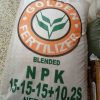Pure Gold Diammonium Phosphate (DAP) Fertilizer -50kg
₦39,000.00
45 people are viewing this product right now
🔥 8 items sold in last 3 hours
Pure Gold Diammonium Phosphate is the most thought phosphate-based manure. It is ideally suited for any agribusiness yield to give full phosphorus nourishment all through crop development and improvement, as well as a starter portion of nitrogen and low sulfur.
Item includes
Bundle size: 50kg
Buy more save more!
Buy from 5 to ∞ items and get 5% OFF
on each productPure Gold Diammonium Phosphate is the world’s most broadly utilized phosphorus compost. It’s produced using two normal constituents in the manure business, and its generally high supplement content and superb actual properties make it a famous decision in cultivating different ventures.
Ammonium phosphate manures previously opened up during the 1960s, and DAP quickly turned into the most famous in this class of items. It’s planned in a controlled response of phosphoric corrosive with alkali, where the hot slurry is then cooled, granulated, and sieved. DAP handles and stores well. The standard supplement grade of DAP is moderately high, at 18-46-0, so compost items with lower supplement content may not be named DAP.
Pure Gold Diammonium Phosphate tends to be applied for plowing and during planting, as well as concerning pre-planting development. Dissolving in soil, gives brief alkalization of pH of the dirt arrangement around the manure granule, along these lines invigorating better take-up of phosphorus from the composts on corrosive soils. Manure’s sulfur additionally adds to the better admission of nitrogen and phosphorus by plants.
The information sources expected to create one ton of DAP manure are around 1.5 to 2 tons of phosphate rock, 0.4 lots of sulfur (S) to break down the stone, and 0.2 lots of alkali. Changes in the inventory or cost of any of these information sources will influence DAP costs and accessibility. The high supplement content of DAP lessens dealing with, cargo and application costs. DAP is delivered in numerous areas on the planet and is a broadly exchanged compost product.
FAQs
What is Pure Gold Diammonium Phosphate (DAP) fertilizer?
Pure Gold DAP is a widely used phosphorus fertilizer made from common fertilizer industry ingredients. Its high nutrient content and good handling characteristics make it a popular choice for agricultural and other applications.
When was DAP fertilizer developed?
Ammonium phosphate fertilizers emerged in the 1960s, with DAP quickly becoming the most popular type.
How is DAP fertilizer produced?
DAP is created through a controlled reaction between phosphoric acid and alkali. The resulting hot slurry is cooled, granulated, and sieved for easy application.
What is the nutrient content of DAP fertilizer?
Standard DAP fertilizer has a high nutrient content, typically around 18-46-0 (nitrogen-phosphorus-potassium). Fertilizers with lower nutrient content wouldn’t be classified as DAP.
How is DAP fertilizer applied?
DAP is commonly applied during plowing, planting, or pre-planting cultivation. It can help improve phosphorus uptake in acidic soils and provides some sulfur for better overall nutrient absorption by plants.
What are the raw materials needed for DAP production?
Producing one ton of DAP fertilizer requires approximately:
- 1.5 to 2 tons of phosphate rock
- 0.4 tons of sulfur (S)
- 0.2 tons of alkali
How does the cost of raw materials affect DAP fertilizer?
Fluctuations in the availability or price of any of these raw materials can impact the cost and accessibility of DAP fertilizer.
What are the benefits of DAP fertilizer?
- High nutrient content reduces handling, transportation, and application costs.
- DAP is readily available worldwide and is a widely traded fertilizer product.
- It can improve phosphorus uptake in acidic soils and provides some sulfur for better overall nutrient absorption.
Only logged in customers who have purchased this product may leave a review.
Related products
₦10,400.00


₦65,000.00









Reviews
There are no reviews yet.